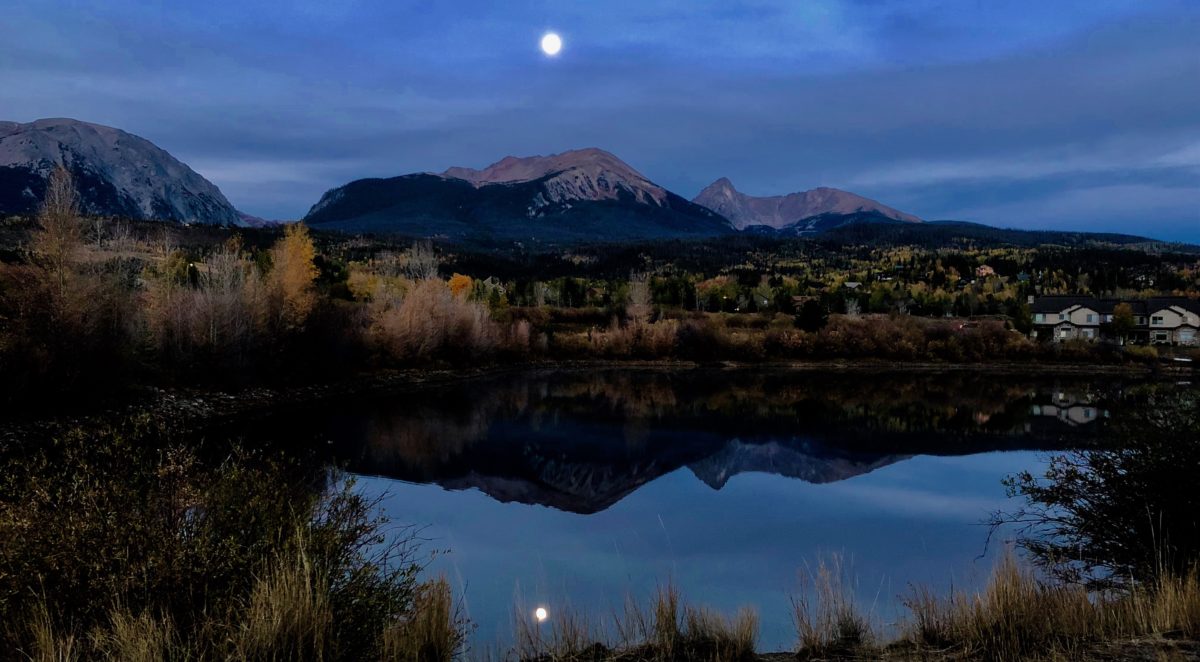
Advent Manifesto: Does My Soul Still Sing?
Image by John Paul Lederach, © All Rights Reserved.
First words
I too decided to write an orderly account for you.
Luke 1:3
1.
Some good friends in the world of Mennonite publications asked if I might write a few Advent reflections on hope in times of despair, inspired in part by my practice of haiku poetry.
2.
I am not nearly as orderly as Luke and his Chapters 1 and 2, where Advent inspiration tends to reside. I opted for this numbering style of writing. I follow my thoughts where they lead. This can be chaotic, especially when one listens with the ear of the heart, as St. Benedict once remarked.
3.
Philosopher Ludwig Wittgenstein used a similar writing method. For a time, I required my students to write a Wittgensteinian essay: Start with one idea. Notice where it goes. Number each idea. Keep them short. Don’t worry if you hop around. Read and play with what emerges. It may take a while to understand what you are trying to say. To yourself.
4.
I discovered that the Desert Fathers and other ascetics employed this approach. They sought a way to move from contemplative sense to paper. Sometimes they called what they wrote a century: 100 pieces of heart-sourced inklings. Heart to hand to ink. Follow what comes. Only the numbers seem orderly. Like prayer.
5.
Luke apparently had a clear reader-partner. Theophilus. But you, my reader friend, I have no idea who you might be, and it seemed proper for me to offer an initial confession or two, a forewarning perhaps.
6.
I recently was approached by an older, gentle, and evangelizing couple in Washington, D.C. They were conducting a survey about whether people were going to church. By the end of our conversation, the kindly woman said: I just hope that if you were to die today you would be certain that you will go to heaven.
7.
I am Mennonite. I don’t go to church much.
8.
I am a contemplative. I go to Church every day.
9.
I just hope that today, I am awake enough to notice God breaking unexpectedly within, between, and around us.
10.
Being awake is an Advent thing: To notice the mystery that keeps us human, grounded, grateful, and grace filled. In this minute. In this conversation. In this day. In this century. It’s why I practice the small 5-7-5 syllable tapping of haiku poetry. It provokes me to notice. Where I am. Now.
11.
Our language for talking about what stirs in the soul has been tailspinning these days. I find precious little in religious speak that speaks to what stirs in my soul. Forasmuch as many have taken in hand to set forth, I will err toward the unruly.
12.
Just prior to writing you, I was an eyewitness of these things: I spent time in Colombia, where they are trying to end a half-century war. I attended a conference, “Confronting Hate,” in Washington, D.C. I followed recent Supreme Court hearings and occasional rallies. I went with Wendy, my wife, to her biannual doctor’s appointment to assess her Parkinson’s. I work with a team supporting youth in South Sudan trying to break from the claws of genocide.
13.
None of these has an Advent quality. Many have an abundance of haiku, if we hone our poetic listening and slow down enough to be, as Luke wrote to Theophilus, instructed.
Speechless
And now you will be silent and not able to speak.
Luke 1:18
14.
In late September and early October, I watched and read too much news. If you so wished, you could be an hourly eyewitness to how people are choosing to lead in America these days, to how we seek truth and speak with each other and to how we as a nation ordain our judges.
15.
At one point, I turned off all sound and just observed faces. With rare exception, I saw raw suffering.
16.
Some of the suffering took a few people toward slower, inner reflection. Some of the suffering took the many toward rage.
17.
We seem to live in an age of rage.
18.
I watched America devour herself.
19.
My soul felt battered. My feet quagmired. My hands could not write. A sad heart climbed into my throat looking for refuge.
20.
My tongue went Zechariah.
21.
Just prior to attending the “Confronting Hate” gathering, I spent a Sunday morning with my wife and daughter walking the mall in Washington, D.C.: From Lincoln down past the Vietnam and Korean walls, along Independence Avenue into the gaze of Martin Luther King Jr., then awash in the fountains of the Roosevelts.
22.
Granite spoke. Some slabs cried. Others pled. One called out: From a mountain of despair, a stone of hope.
23.
Sleepless in my native land
What
desert
this
where
beauty and thirst
abound?
24.
When we in this country behave this poorly, a nation that stands on simple truths about equality, respect, life, and freedom, perhaps the time has come to be silent.
25.
I noticed in Luke 1, the preparatory advent, men spoke very little. Women rose with voice. It seemed a most divine strategy for this American century.
Long and restless nights
How will this be?
Luke 1:34
26.
Wendy has passed the 10-year anniversary of her diagnosis. Parkinson’s disease. Progressive and chronic remain the preferred medical descriptors. Odd poets, these medicine people.
27.
We’ve been married 38 years. PD has now occupied more than a quarter of our shared life. A few more years and it will reach one-third.
28.
The jitters came unannounced and uninvited. Parkinson’s does not strike like lightning. It arrives like winter creeping in, unnoticed as the bits of daylight are stolen by shadows of stretching night.
29.
Nights can be long and restless.
30.
Five years back, I took over the dismaying monthly challenge of pill herding. Most everything, except the shakes and stumbles, remain invisible to the naked eye. Invisibility is the hard part. Moving slower and slower in a world that does not stop spinning and does not take notice.
31.

Parkinson’s cycle
Medicine in.
Tears out.
Salty life rolls on.
32.
Last evening, her Lazy Boy chair wouldn’t kick out. I went over and pulled the handle. She sank back. Nothing is easy, a whisper crossed the room.
33.
We rarely notice small things until they have disappeared.
34.
I have navigated landscapes of human suffering over the years. Little prepared me for sitting alongside the experience of slow grief.
35.
A thin, mostly invisible border sits between grief and grievance. On the other side of grievance, mountains of anger and blame rise on the near horizon. Their runoff waters flood the valleys with despair and hate. I know these frontiers. I have crossed the borders a good bit.
36.
I feel the border crossings now in this creep of spreading rage.
37.
Note to self
bitter weeds
grow wild at the edge
of the Sadness Pool
sometimes they send
bile-seeds to innocent places
sometimes they poison
the source
it may be wise
to sit deep in the Pool
and take care
with your edges
Furrows
Mary treasured up all these things.
Luke 2:19
38.
Colombia abolished slavery on May 21, 1851. History, apparently, holds some seeds of light.
39.
The U.S. abolished slavery 15 years later and only after a civil war that lasted four years. That was the decade of 1860s. Around 700,000 people died. History books suggest our civil war ended on May 9, 1865. That’s when the bullets stopped.
40.
But when do wars end, really?
41.
we have been slow to
notice that we are still buried
in war’s deep furrows
42.
My great grandmother Lydia Miller was born in 1869, the end of the decade of our Civil War. She lived through 97 years. I sat on her lap when I was young. The youngest member of my extended family is Amelie. She was born in 2010. She has sat on my lap. If Amelie follows her great-great-great-grandmother Lydia or her great-great-grandmother Nona, she may well see the next century. 1869 to 2100. These are the birth- to full-life dates of those who touched me and I have touched.
43.
Elise Boulding called this our 200-year present.
44.
Having been close to contexts of armed conflict, bitter loss, and deep division for nearly 40 years, I have found one thing to be true: Wars never end easy. And they never end when the bullets stop.
45.
Wars have lives. They leave legacies many are born to, decades and centuries later.
Glistening
The rising sun will shine on us.
Luke 1:78
46.
While the infinite nature of God-as-Creator holds unimaginable complexity, the presence of the Divine among us seems to follow simple guideposts. For example, love of diversity in nature and human life is far more prevalent than uniformity. Or, acceptance and equality are incarnated through the fundamental commitment that the sun and rain are offered to all. No exceptions.
47.
Rain has this intriguing quality. Droplets fall as individuated little spheres. Once splashed, however, rain spreads, melds, and flows. When mixed with the sudden appearance of the sun, it makes everything shine.
48.
Rain glistens to everything.
49.
Mediators and bridge builders spend a lot of time preparing to listen. To my knowledge, nobody has trained us on how to glisten.
50.
To glisten: To be present with others in ways that help them shine into their deepest color, purpose, and wisdom. As example: Mary and Joseph glistened to the unexpected seed they carried toward the light of day.
51.
Elise Boulding also suggested that in the midst of human conflict we have many prophets who speak and few who listen. Prophetic listening emerges when people feel held with such a quality of care and patience that as they speak it becomes possible for them to hear themselves, to tap a deeper understanding, to sense how God may be trying to break into their life.
52.
I once learned this Indonesian proverb:
The ox is slow, but the earth is patient.
53.
I have some friends in Colombia who have lived through decades of armed violence. They decided to live into a small habit: We will seek to understand those who do not understand us.
54.
We listen to God about as well as we listen to those we do not agree with.
55.
Rain would advise that we might try to glisten.
56.
misty cloud cascade
glistening to everything
sky and earth singing
Us and them
And everyone went to their own town.
Luke 2:3
57.
I recently saw a visualization of large data that tracked digital communication between liberal and conservative blogs. It looks like a colorful amoeba splitting. A large chunk of blue was splitting from an equally large chunk of red. The very small portion of yellow appeared to be the stressed connective tissue that had not yet lost contact with either color.
58.
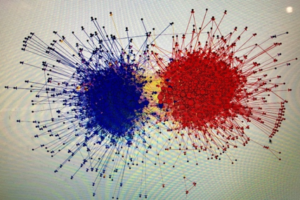
59.
The colors represented an exploration of communication in blogs around the Presidential election of 2004. Lada Adamic and Natalie Glance, who tracked and visualized this data, observed that 91 percent of the communication stayed in the community where it originated. Basically, people talking with people who say and hear, then hear and say, the same thing. That was 15 years back.
60.
Everyone just stayed in their preferred hearsay.
61.
This week, did 91 percent of our communication stay only in the hometown of like-minded folk where it originated? I confess too much of mine did.
62.
Did yours?
63.
through a light snowfall
silver canoe at lake’s edge
watches heron still
Vocational pause
There is no one among your relatives who has that name.
Luke 1:61
64.
I once started writing a book on whole faith-body Christian vocation. It was perhaps an odd twist of terms. Some people would call whole faith body a church. Some might call it a denomination or a tradition. In the big picture of Christian history, we are an astonishingly motley set of faith bodies all professing to follow Jesus.
65.
When it comes to faith, we are prone to boundary our uniqueness. We like borders. We like walls. We want to know who is in and who is out. Diversity diminishes toward divisive, dismissive, and definitive. We seem to connect borders with belonging and divine virtue.
66.
I have little interest in bordered belonging. I am drawn to boundary-less belonging.
67.
Advent: Preparing for when God breaks through and beyond borders.
68.
In this not-published book, I wondered whether our whole faith-body differences might actually hold hidden, uniquely treasured gifts that lift forward a facet of the bejeweled Divine. We usually think of vocation as something personal. What am I called and living into? But what if whole traditions emerged to carry a vocation? What if an entire denomination was birthed to lift forward one facet of God?
69.
It was easier to explore this idea through the “one thing” question: What one thing of God’s essence would our world miss if, say, there was no Catholic tradition? Or we were without the Russian Orthodox Church? Or the Nazarenes, the Baptists, the Pentecostals? Whatever that one thing is, it might just hold the vocational seed-center of that whole faith body.
70.
What if no Mennonites existed? What one thing would the world be missing?
71.
I would answer: The Dirk Willems moment.
72.
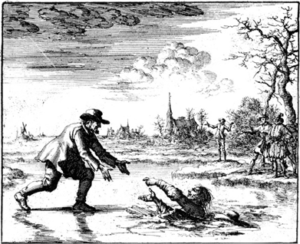
73.
Dirk was a 16th-century Anabaptist. He was captured and tried for his views of what he felt it meant to follow Jesus. Jailed and awaiting the decision on how he would be put to death, he had an unexpected chance to escape. He bolted from his cell and ran across the thin ice of a nearby lake, his jailer in pursuit. Dashing at full speed, he heard a loud crack and then the anguished cries of the man chasing him who had fallen into icy water. He stopped. He listened. He turned. He made his way back. He reached out, offering open hands to someone who wished him harm. A few days later, Dirk was put to death.
74.
We Mennonites are the odd bunch that celebrate his action that day as a sign of God’s love and courage.
75.
If Mennonites did not exist, the world would be without a small patch of quilters who believe and live into a quality of love that reaches out and stitches together even those who wish us harm. That’s the facet of the bejeweled Divine that might go missing.
76.
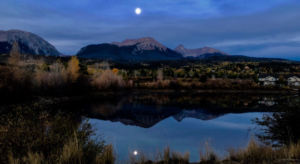
moon fell in the lake
I drank a full white chalice
skin shivering fire
Memory and grace
Remembering to be merciful
Luke 1:54
77.
On my last trip to Colombia, I discovered that in 1851, President José Hilario López mandated that a ceiba tree be planted to commemorate the abolition of slavery. The ceiba can grow hundreds of feet with an extensive canopy. They can live for more than 200 years.
78.
Thinking about the ceiba, I was reminded of Neles Tebay. A journalist by training and peacebuilder by vocation, Father Neles has worked most of his life to bring peace between Indonesia and his native Papua. Sauntering with him on a wooded pathway in Virginia, Neles recounted a story. When he was young, his father would take him into thick tropical jungles to pass on wisdom. Always remember, Neles, his father would say, the forest accepts all people.
79.
Ceiba trees take root in rural areas of Colombia, the lands that over the past 50 years have been trampled by horrific violence. At the feet of ceibas, people of all sorts and varieties have sat in their shade: paramilitaries, army foot soldiers, women stopping to catch a breath in the midst of fleeing from burnt homes, guerrilla leaders, old men, young kids.
80.
As far as I know, no ceiba tree has rejected anyone from the shelter of its shade.
81.
Some time back, I was asked about approaches for dealing with extremism and the recruitment of youth into violence. The person posing the question had concerns for what was happening in his community and the appeal and power of hate.
82.
I don’t recall much of my answer. My mind had gone toward the faces of people working with Healing Kashmir and something their founder, Justine Hardy, had once told me.
83.
I had asked Justine the exact same question: From these bloody soils of loss and frustration where you live, how do you work at keeping Kashmiri youth from being drawn to violence? Two pieces stuck with me from our conversation. The lasting damage of war remains in the mind. And. Nothing works unless we can surround people with enough care that they can pause the jittery soul.
84.
At the “Confronting Hate” gathering I was asked if the deepening divides in the United States could carry our country into war. It is not an easy question to answer. Many people across our land face violence on a daily basis. It already feels like a war zone to them. But they were asking about full-blown civil war. I had seven empirical inklings emergent from my field of study.
85.
Easy availability and growing accumulation of weapons associate with increased potential of armed conflict.
86.
When people perceive and believe that the very survival of their primary identity group is under threat, the justification to use violence rises.
87.
When social polarization shifts from blocking enemies from achieving their goals to harming them and then to humiliating them, violence often emerges in response.
88.
When shared social and political institutions weaken and lose legitimacy, violence has increased latitude and license.
89.
When hate speech rises, violence ensues.
90.
When leaders make use of hate speech built around generalized dehumanization of perceived enemies and ratchet up a sense of imminent threat to their in-group followers, violence can be catalyzed.
91.
I also noted that in many places, when violence did break out, leaders quickly distanced themselves from and disavowed those wielding the weapons who had put lives and action to their leaders’ accusations and appeals. By then it’s too late.
92.
Here’s a discovery: It is never too late to transform hate. In the big picture of social change, it matters less what leaders say than the response of first followers.
93.
In Spanish, the verb esperar can translate as both to wait and to hope. Maybe that’s what God breaking across borders to leave a seed with Mary and Joseph really meant: To hold hope with patience for new life. Glisten to furrows, not divides.
94.
it’s so dark in here
something seeks the light of day
the life of a seed
Five haikus and one poem that will not go away this Advent
Mary pondered all these things in her heart.
Luke 2:19
95.
do you think we could
be at the brink of a war
and not take notice
96.
what sort of courage
holds people together when
everything else splits
97.
Don’t mistake a quilt for a battlefield
to hem extremism
surround the wrangling patches
with strong nimble threads
98.
what if churches had
the ceiba’s patience with wide
shade for all to sit
99.
how are we going
to carry our legacy
two-hundred-year gift
100.
Does my soul still sing?
Though the winter’s edge
has stolen the light
long before the night
was supposed to fall,
does my soul still sing?
Maybe she just hums
the late January
crocus’ song.
Notes
Haikus and poems cited in italics are by J.P. Lederach from the forthcoming volume Dreams, Weeds, and Seeds: Things a Mediator Collects.
Adamic, L. and Glance, N. (2005). The Political Blogosphere and the 2004 U.S. Election: Divided They Blog, 4 from http://www.ramb.ethz.ch/CDstore/www2005-ws/workshop/wf10/AdamicGlanceBlogWWW.pdf
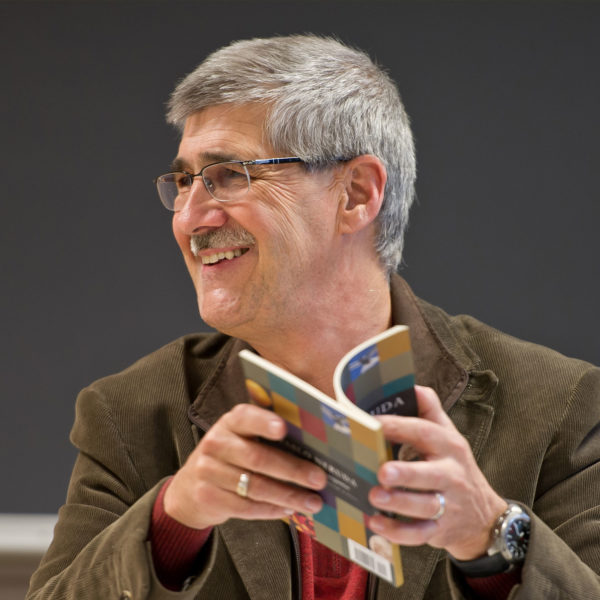
Share your reflection